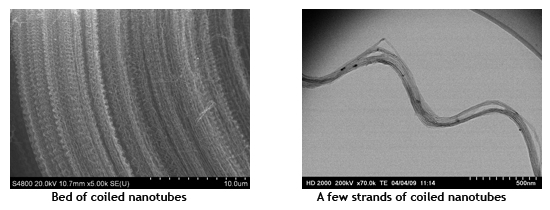Home > Press > Clemson scientists put a (nano) spring in their step
 |
| The corresponding scalebar is in the unit of 1 micrometer (a millionth of a meter) and a nanometer (a billionth of a meter). |
Abstract:
Electronic devices get smaller and more complex every year. It turns out that fragility is the price for miniaturization, especially when it comes to small devices, such as cell phones, hitting the floor. Wouldn't it be great if they bounced instead of cracked when dropped?
Clemson scientists put a (nano) spring in their step
CLEMSON, SC | Posted on August 13th, 2008A team of Clemson University researchers, led by Apparao Rao, professor of physics, has invented a way to make beds of tiny, shock-absorbing carbon springs which possibly could be used to protect delicate objects from damaging impacts. With collaborators at the University of California at San Diego, the team has shown that layers of these tiny springs called coiled carbon nanotubes, each a thousand times smaller than a human hair, can act as extremely resilient shock absorbers.
Similar coiled carbon nanotubes have been made before, yet Clemson researchers say this method is unique since beds of coiled carbon nanotubes can be grown in a single step using a proprietary hydrocarbon-catalyst mixture.
The group also envisions coiled nanotubes in soldiers' body armor, car bumpers and bushings and even as cushioning elements in shoe soles.
"The problem we have faced in the past is producing enough of these coiled carbon nanotubes at a reasonable cost to make a difference," said Rao. "Because our current method produces coiled nanotubes quickly in high yield, it can be readily scaled up to industrial levels. After formation, the coiled nanotubes can be peeled off in one piece and placed on other surfaces to form instant cushioning coatings."
In earlier studies, Rao and his team, along with UCSD collaborators, tested more conventional straight carbon nanotubes against coil-shaped nanotubes. When a stainless steel ball was dropped onto a single nanotube layer, the coiled nanotubes completely recovered from the impact, while the straight ones did not.
"It's like an egg toss," said Rao. "If you move your hand backward as you catch the egg and increase the time of contact over which the impact occurs, the impact will be less forceful and the egg will not break. It is the same phenomenon experienced in catching a baseball."
In previous work, Rao's group developed a process that coaxes a traditionally straight carbon nanotube to split into a "Y" shape. When powered by electrical voltages, the Y-branched nanotubes behave like tiny switches or transistors that process information.
"Our studies with carbon nanotubes have been ongoing for quite some time," said Rao. "Each step along the way has led to the next breakthrough, and each time we've learned more about how they grow and what their applications could be. We believe that carbon nanotubes have tremendous potential for the lives of each one of us."
####
For more information, please click here
Contacts:
Apparao Rao
(864) 656-6758
WRITER: Susan Polowczuk
(864) 656-2063
Copyright © Clemson University
If you have a comment, please Contact us.Issuers of news releases, not 7th Wave, Inc. or Nanotechnology Now, are solely responsible for the accuracy of the content.
| Related News Press |
News and information
![]() Researchers develop molecular qubits that communicate at telecom frequencies October 3rd, 2025
Researchers develop molecular qubits that communicate at telecom frequencies October 3rd, 2025
![]() Next-generation quantum communication October 3rd, 2025
Next-generation quantum communication October 3rd, 2025
![]() "Nanoreactor" cage uses visible light for catalytic and ultra-selective cross-cycloadditions October 3rd, 2025
"Nanoreactor" cage uses visible light for catalytic and ultra-selective cross-cycloadditions October 3rd, 2025
Discoveries
![]() Researchers develop molecular qubits that communicate at telecom frequencies October 3rd, 2025
Researchers develop molecular qubits that communicate at telecom frequencies October 3rd, 2025
![]() Next-generation quantum communication October 3rd, 2025
Next-generation quantum communication October 3rd, 2025
![]() "Nanoreactor" cage uses visible light for catalytic and ultra-selective cross-cycloadditions October 3rd, 2025
"Nanoreactor" cage uses visible light for catalytic and ultra-selective cross-cycloadditions October 3rd, 2025
Announcements
![]() Rice membrane extracts lithium from brines with greater speed, less waste October 3rd, 2025
Rice membrane extracts lithium from brines with greater speed, less waste October 3rd, 2025
![]() Researchers develop molecular qubits that communicate at telecom frequencies October 3rd, 2025
Researchers develop molecular qubits that communicate at telecom frequencies October 3rd, 2025
![]() Next-generation quantum communication October 3rd, 2025
Next-generation quantum communication October 3rd, 2025
![]() "Nanoreactor" cage uses visible light for catalytic and ultra-selective cross-cycloadditions October 3rd, 2025
"Nanoreactor" cage uses visible light for catalytic and ultra-selective cross-cycloadditions October 3rd, 2025
|
|
||
|
|
||
| The latest news from around the world, FREE | ||
|
|
||
|
|
||
| Premium Products | ||
|
|
||
|
Only the news you want to read!
Learn More |
||
|
|
||
|
Full-service, expert consulting
Learn More |
||
|
|
||








